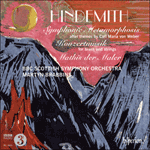The
Konzertmusik for brass and strings, Op 50, was commissioned to celebrate the fiftieth anniversary of the Boston Symphony Orchestra. It is the final piece in a triptych of similarly titled works from 1929–30, which offer perspicuity while preserving harmonic and structural sophistication. Like the earlier
Kammermusik, they recall the concertino and ripieno groups of the Baroque concerto grosso, here applied to two departments of the orchestra. In the first part—itself comprising two sections—the brass states a bold chorale-like theme against energetic string counterpoint. Hindemith continues to make a virtue of the timbral differences between the two instrumental groups, not least in the fugue that dominates the second part of the work. The busy chatter of the exposition is the strings’ domain, while the brass provides three-chord punctuation. The viola, Hindemith’s instrument, leads the middle section, as yearning as the fugue was determined, before the counterpoint kicks in once more.
from notes by Gavin Plumley © 2013
La
Konzertmusik pour cuivres et cordes, op. 50, commandée pour le cinquantième anniversaire de l’Orchestre symphonique de Boston, est le dernier volet d’un triptyque d’œuvres portant le même titre qui datent des années 1929–30 et font preuve de netteté tout en conservant une sophistication harmonique et structurelle. Comme les
Kammermusik antérieures, elles rappellent le concertino et le ripieno du concerto grosso baroque, appliqués ici aux deux sections de l’orchestre. Dans la première partie—qui comprend elle-même deux sections—les cuivres exposent un thème vigoureux à la manière d’un choral sur un contrepoint énergique des cordes. Hindemith continue à tirer parti des différences de timbres entre les deux groupes instrumentaux, entre autres dans la fugue qui domine la seconde partie de l’œuvre. Le bavardage animé de l’exposition est du domaine des cordes, pendant que les cuivres apportent une ponctuation de trois accords. L’alto, l’instrument de Hindemith, mène à la section centrale, aussi ardente que la fugue était déterminée, avant le retour du contrepoint.
extrait des notes rédigées par Gavin Plumley © 2013
Français: Marie-Stella Pâris
Die
Konzertmusik für Streichorchester und Blechbläser, op. 50, ein Auftragswerk zum 50-jährigen Bestehen des Boston Symphony Orchestra, ist das letzte von drei Werken mit ähnlichen Titeln aus den Jahren 1929–30, die bei aller harmonischen und strukturellen Differenziertheit verständlich bleiben. Wie die frühere
Kammermusik erinnern diese Werke an die Concertino- und Ripienogruppen des barocken Concerto Grosso, die hier in zwei Orchesterabteilungen verwendet werden. Im ersten Teil (der selbst aus zwei Abschnitten besteht) spielen die Blechbläser ein kühnes choralartiges Thema vor einem energischen Kontrapunkt der Streicher. Hindemith nutzt weiter vorteilhaft die verschiedenen Timbres der beiden Instrumentengruppen, nicht zuletzt in der Fuge, die im zweiten Teil des Werkes dominiert. Das eifrige Geplapper der Exposition wird von den Streichern ausgeführt, während die Blechbläser Dreiklang-Punktierungen dazu bieten. Die Bratsche, Hindemiths Instrument, führt den mittleren Abschnitt so sehnsuchtsvoll an, wie die Fuge zuvor zielstrebig war, bevor wieder kontrapunktische Passagen einsetzen.
aus dem Begleittext von Gavin Plumley © 2013
Deutsch: Christiane Frobenius


 Hindemith: Symphonic Metamorphosis & other orchestral works
Hindemith: Symphonic Metamorphosis & other orchestral works
